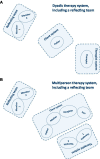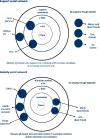Integrative systemic and family therapy for social anxiety disorder: Manual and practice in a pilot randomized controlled trial (SOPHO-CBT/ST)
- PMID: 36405178
- PMCID: PMC9674087
- DOI: 10.3389/fpsyg.2022.867246
Integrative systemic and family therapy for social anxiety disorder: Manual and practice in a pilot randomized controlled trial (SOPHO-CBT/ST)
Abstract
Social anxiety disorders (SAD) are among the most prevalent mental disorders (lifetime prevalence: 7-12%), with high impact on the life of an affected social system and its individual social system members. We developed a manualized disorder-specific integrative systemic and family therapy (ISFT) for SAD, and evaluated its feasibility in a pilot randomized controlled trial (RCT). The ISFT is inspired by Helm Stierlin's concept of related individuation developed during the early 1980s, which has since continued to be refined. It integrates solution-focused language, social network diagnostics, and genogram work, as well as resource- and problem orientation for both case conceptualization and therapy planning. Post-Milan symptom prescription to fluidize the presented symptoms is one of the core interventions in the ISFT. Theoretically, the IFST is grounded in radical constructivism and "Cybern-Ethics," multi-directional partiality, and a both/and attitude toward a disorder-specific vs. non-disorder-specific therapy approach. SAD is understood from the viewpoint of social systems theory, especially in adaptation to a socio-psycho-biological explanatory model of social anxiety. In a prospective multicenter, assessor-blind pilot RCT, we included 38 clients with SAD (ICD F40.1; Liebowitz Social Anxiety Scale, LSAS-SR > 30): 18 patients participated in the ISFT, and 20 patients in Cognitive Behavioral Therapy (CBT; age: M = 36 years, SD = 14). Within-group, simple-effect intention-to-treat analyses showed significant reduction in social anxiety (LSAS-SR; ISFT: d = 1.67; CBT: d = 1.04), while intention-to-treat mixed-design ANOVA demonstrated the advantage of ISFT (d = 0.81). Per-protocol analyses supported these results. The remission rate based on blind diagnosticians' ratings was good to satisfactory (Structured Clinical Interview, SCID; 78% in ST, 45% in CBT, p = 0.083); this has yet to be verified in a subsequent confirmatory RCT. The article will present the ISFT rationale and manual, including a special focus on multi-person settings, and the central findings from our pilot RCT.
Keywords: cognitive-behavioral therapy; feasibility; integrative systemic and family therapy (ISFT); manual; multi-person; pilot; randomized controlled trial; social anxiety.
Copyright © 2022 Hunger-Schoppe, Schweitzer, Hilzinger, Krempel, Deußer, Sander, Bents, Mander and Lieb.
Conflict of interest statement
The authors declare that the research was conducted in the absence of any commercial or financial relationships that could be construed as a potential conflict of interest.
Figures




Similar articles
-
Comparing Cognitive Behavioral Therapy and Systemic Therapy for Social Anxiety Disorder: Randomized Controlled Pilot Trial (SOPHO-CBT/ST).Fam Process. 2020 Dec;59(4):1389-1406. doi: 10.1111/famp.12492. Epub 2019 Oct 27. Fam Process. 2020. PMID: 31657011 Clinical Trial.
-
Comparing systemic therapy and cognitive behavioral therapy for social anxiety disorders: study protocol for a randomized controlled pilot trial.Trials. 2016 Mar 31;17:171. doi: 10.1186/s13063-016-1252-1. Trials. 2016. PMID: 27029546 Free PMC article. Clinical Trial.
-
Internet-Based Cognitive Behavioral Therapy With Real-Time Therapist Support via Videoconference for Patients With Obsessive-Compulsive Disorder, Panic Disorder, and Social Anxiety Disorder: Pilot Single-Arm Trial.J Med Internet Res. 2018 Dec 17;20(12):e12091. doi: 10.2196/12091. J Med Internet Res. 2018. PMID: 30559094 Free PMC article.
-
Mindfulness-based therapy versus cognitive behavioral therapy for people with anxiety symptoms: a systematic review and meta-analysis of random controlled trials.Ann Palliat Med. 2021 Jul;10(7):7596-7612. doi: 10.21037/apm-21-1212. Ann Palliat Med. 2021. PMID: 34353047
-
Long-term outcome of cognitive behaviour therapy clinical trials in central Scotland.Health Technol Assess. 2005 Nov;9(42):1-174. doi: 10.3310/hta9420. Health Technol Assess. 2005. PMID: 16266559 Review.
Cited by
-
Interaction-focused music therapy with cancer-affected children and their significant others: a randomized controlled feasibility study with subsequent intervention (INMUT).Pilot Feasibility Stud. 2024 May 28;10(1):86. doi: 10.1186/s40814-024-01490-8. Pilot Feasibility Stud. 2024. PMID: 38807165 Free PMC article.
-
Does Intolerance of Uncertainty Influence Social Anxiety Through Rumination? A Mediation Model in Emerging Adults.Behav Sci (Basel). 2025 May 16;15(5):687. doi: 10.3390/bs15050687. Behav Sci (Basel). 2025. PMID: 40426463 Free PMC article.
References
-
- Andersen T. (1991). The Reflecting Team: Dialogues and Dialogues About the Dialogues. New York, NY: Norton & Co
-
- Bateson G. (2000). Steps to an Ecology of Mind: Collected Essays in Anthropology, Psychiatry, Evolution, and Epistemology. Chicago: University of Chicago Press
-
- Borkovec T. D., Nau S. D. (1972). Credibility of analogue therapy rationales. J. Behav. Ther. Exp. Psychiatry 3, 257–260., PMID: - PubMed
-
- Borst U. (2017). Niemand ist alleine persönlichkeitsgestört. Persön. Theo. Therap. 21, 189–194.
LinkOut - more resources
Full Text Sources
Research Materials

